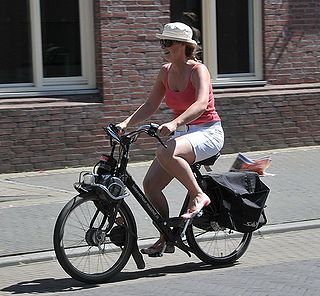
A vehicle is a machine that transports people or cargo. Vehicles include wagons, bicycles, motor vehicles, railed vehicles, watercraft, amphibious vehicles, aircraft and spacecraft.

A hybrid vehicle is one that uses two or more distinct types of power, such as submarines that use diesel when surfaced and batteries when submerged. Other means to store energy include pressurized fluid in hydraulic hybrids.

A velomobile, velomobiel, velo, or bicycle car is a human-powered vehicle (HPV) enclosed for aerodynamic advantage and/or protection from weather and collisions. They are similar to recumbent bicycles, pedal go-karts and tricycles, but with a full fairing. A fairing may be added to a non-faired cycle, or the fairing may be an integral part of the structure, monocoque like that of an airplane. The term velomobile can be thought of as similar in scope to the cycle world as the term automobile is to the automotive world.

A transmission is a machine in a power transmission system, which provides controlled application of power. Often the term 5-speed transmission refers simply to the gearbox, that uses gears and gear trains to provide speed and torque conversions from a rotating power source to another device.

A drive shaft, driveshaft, driving shaft, tailshaft, propeller shaft, or Cardan shaft is a vehicle component for transmitting mechanical power and torque and rotation, usually used to connect other components of a drivetrain that cannot be connected directly because of distance or the need to allow for relative movement between them.
Two-wheel-drive (2WD) denotes vehicles with a drivetrain that allows two wheels to be driven, and receive power and torque from the engine, simultaneously.

A drive wheel is a wheel of a motor vehicle that transmits force, transforming torque into tractive force from the tires to the road, causing the vehicle to move. The powertrain delivers enough torque to the wheel to overcome stationary forces, resulting in the vehicle moving forwards or backwards.

A motorized bicycle is a bicycle with an attached motor or engine and transmission used either to power the vehicle unassisted, or to assist with pedalling. Since it always retains both pedals and a discrete connected drive for rider-powered propulsion, the motorized bicycle is in technical terms a true bicycle, albeit a power-assisted one. However, for purposes of governmental licensing and registration requirements, the type may be legally defined as a motor vehicle, motorbike, moped, or a separate class of hybrid vehicle.

An electric bicycle, also known as an e-bike or ebike, is a bicycle with an integrated electric motor used to assist propulsion. Many kinds of e-bikes are available worldwide, but they generally fall into two broad categories: bikes that assist the rider's pedal-power and bikes that add a throttle, integrating moped-style functionality. Both retain the ability to be pedaled by the rider and are therefore not electric motorcycles.
Many countries have enacted electric vehicle laws to regulate the use of electric bicycles. Countries such as the United States and Canada have federal regulations governing the safety requirements and standards of manufacture. Other countries like the signatories of the European Union have agreed to wider-ranging legislation covering use and safety.
Hybrid vehicle drive trains transmit power to the driving wheels for hybrid vehicles. A hybrid vehicle has multiple forms of motive power.
A motorcycle is a single-track two-wheeled motor vehicle. It is also known as a motorbike.

The General Motors Precept was a 2000 low emission vehicle concept car aimed at meeting the 80 mpg‑US fuel economy goal of the Partnership for a New Generation of Vehicles between the US Government and GM, Ford, and Chrysler. GM was able to meet the 80 mpg‑US fuel economy goal with the Precept, creating versions using Lithium and NiMH batteries with diesel, fuel cell and other hybrid version of the car.

A human–electric hybrid vehicle is a hybrid vehicle, or more specifically a hybrid human-powered vehicle, whose drivetrain consists of a human being and an electric motor/generator. Some vehicles are able to operate off both human power and be plugged in to operate on battery power.

A rear-engine, front-wheel-drive layout is one in which the engine is between or behind the rear wheels, and drives the front wheels via a driveshaft, the complete reverse of a conventional front-engine, rear-wheel-drive vehicle layout.

Bicycle drivetrain systems are used to transmit power on bicycles, tricycles, quadracycles, unicycles, or other human-powered vehicles from the riders to the drive wheels. Most also include some type of a mechanism to convert speed and torque via gear ratios.

Human-powered land vehicles are land vehicles propelled over ground by human power. The main ways to support the weight of a human-powered land vehicle and its contents above the ground are rolling contact; sliding contact; intermittent contact; no contact at all as with anything carried; or some combination of the above. The main methods of using human power to propel a land vehicle are some kind of drivetrain; pushing laterally against the ground with a wheel, skate, or ski that simultaneously moves forward; by pushing against the ground directly with an appendage opposite to the direction of travel; or by propeller. Human-powered land vehicles can be propelled by persons riding in the vehicle or by persons walking or running and not supported by the vehicle.

The drivetrain, also frequently spelled as drive train, or sometimes drive-train, is the group of components of a motor vehicle that deliver power to the driving wheels. This excludes the engine or motor that generates the power. In contrast, the powertrain is considered to include both the engine and/or motor(s), as well as the drivetrain.

An all-wheel drive vehicle is one with a powertrain capable of providing power to all its wheels, whether full-time or on-demand.














